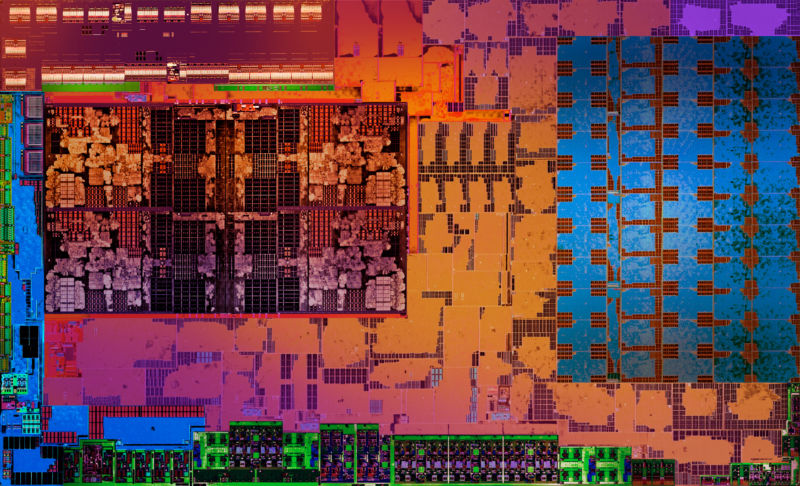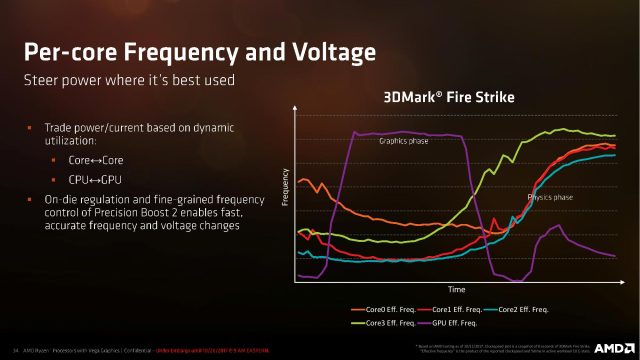
AMD announced today its first two processors to combine its new Zen CPU architecture with its Vega graphics. The new chips, aimed at lightweight mobile systems, go head to head with Intel's U-series processors, and for the first time in many years, AMD is going to have competitive chips in the thin-and-light laptop market.
AMD's Ryzen and Threadripper processors re-established AMD's chips as competitive with Intel's. While the AMD parts gave up a bit of performance to their Intel rivals, especially in single-threaded tasks—a result of the combination of slightly lower clock speeds and slightly inferior instructions-per-cycle (IPC)—they shine in multithreaded tasks, with AMD often offering many more cores and threads than Intel for the same or less money.
In the mainstream desktop space, Intel's Coffee Lake chips have reasserted that company's dominance; Skylake-X does the same in the high-end desktop space, too, albeit at a high price.
But things are looking like they're going to be different in the mobile space. That's because the two new chips, the Ryzen 7 2700U and Ryzen 5 2500U, show signs of being faster in both processor and graphics tasks than Intel's latest comparable chips.

Both chips include a single Zen CCX: that's a module containing four cores and eight threads, along with 4MB of level 3 cache. They integrate this with either 10 Vega compute units (CUs) for the 2700U or eight CUs for the 2500U. The 2700U has a base clock speed of 2.2GHz, boosting up to 3.8, and a GPU clock speed of up to 1.3GHz. The 2500U shaves off 200MHz from all of these speeds.
Like Intel's U-series chips, these chips have a nominal 15W power draw, and similar to Intel's U-series, system builders can configure this, going as high as 25W for systems with strong cooling or as low as 12W (Intel's limits are the same 25W at the high end but a lower 10W at the low end).
Those raw numbers tell an important story. The latest Intel parts, the "8th generation" Kaby Lake-R chips, match the same basic specs: 15W, four cores, eight threads. But in contrast to the desktop chips, where Intel's processors have both a clock speed and IPC advantage, the Kaby Lake-R parts operate at a clock speed disadvantage. Intel's latest and greatest Core i7-8550U has a base clock of just 1.8GHz. AMD still trails Intel in IPC, but with the 2700U's base clock of 2.2GHz—more than 20 percent higher than that of the 8550U—the AMD processor is often able to pull ahead of the Intel one.
As with its initial Ryzen release, AMD is leaning heavily on a few benchmarks to showcase the performance of its new chips. Cinebench has been a recurring theme of the company's marketing. In the rendering benchmark's single-threaded test, the Kaby Lake-R chip is about 10 percent faster. Under single threaded workloads, the slightly higher maximum turbo frequency and IPC advantage wins out. But in the multithreaded test, where clock speeds tend to be much closer to "base" than "turbo," the AMD chip has a whopping 44-percent lead. Ryzen already showed that AMD's simultaneous multithreading implementation (the ability to run two threads concurrently on a single core) showed big advantages. That, combined with a higher clock speed, allows the Ryzen to soundly beat the Kaby Lake-R.
Similar results are found in POVRay (another multithreaded rendering test), PCMark 10 (a mainstream productivity workload), and TrueCrypt (encryption). Only in PassMark 9, another productivity-style benchmark, does Intel come out ahead.
-
The new chips take integrated GPU performance to a new level.AMD
-
It's not a gaming powerhouse, but the performance should be enough for light gaming.AMD
On the graphics side, the difference is even more pronounced; in the Time Spy subtest of 3DMark, AMD is claiming performance of more than double that of Kaby Lake-R, even edging slightly ahead of a previous generation Kaby Lake paired with a GeForce 950M discrete GPU. Integrated graphics are never going to make these systems into gaming powerhouses, but AMD is claiming respectable framerates (minimum of 30, sometimes averaging as high as 60fps) across a range of games (including Dota 2 and Overwatch), albeit at reduced quality settings. As a stopgap to enable some light gaming while on the road, the Ryzen parts look like they'll do a tolerable job.

In bringing Zen to the mobile space, AMD has made some changes to power management and clock speed handling. The desktop Ryzen chips have quite a rudimentary clock boosting system. Precision Boost in the desktop chips has an all-cores boost level and a two-core boost level but nothing in between. A workload that exercises four of the eight cores of a desktop Ryzen will not be able to use the thermal and power budget to boost all of those four active cores beyond the all-cores boost level, even though there will often be headroom to do so.
The mobile parts introduce Precision Boost 2. This scraps the difference between the two cores and all-cores boost levels; the mobile chips can increase the clock speed of one, two, three, or all four cores, as long as there is power and thermal freedom to do so. This should enable higher average clock speeds to be maintained even under workloads with more active threads than the desktop chips can currently achieve.

That same clock speed control, with the power and thermal constraints, also applies to the GPU, with the chip's power management system trading off power between the individual CPU cores and the GPU core depending on load and headroom.
As with any modern mobile chip, the processors use power gating to enable parts to be turned off when not in use. Some 95 percent of the GPU can be powered down, as can all of the cores. In this state, power to the processor is substantially turned off, leaving only the bare minimum necessary to draw the screen—the display controller and the memory controller to feed it—enabled. At a static Windows desktop, AMD says that the chips can be in this powered-down state 99 percent of the time. The multimedia hub can also be powered separately from the CPU and main GPU core, so scenarios such as showing hardware-accelerated streaming video can keep the processor in its "mostly powered down" state for longer.
The multimedia engines have themselves been upgraded, relative to prior AMD mobile chips. They now support 10-bit H.265/HEVC decoding for 4K video and VP9. This yields particularly substantial improvements in battery life for streaming media, with AMD estimating twice the battery life relative to its older generation of processors.
-
HP Envy x360.AMD
-
Lenovo IdeaPad 720S.AMD
-
Acer Swift 3.AMD
The initial launch of the new Ryzens will be limited. The first three laptops are all Ryzen versions of existing consumer-oriented designs (either from AMD or Intel), released in time for the holiday season. A more complete line-up, including corporate-oriented machines, will come to market from early next year. The three launch systems are a 15-inch HP Envy x360, a 13-inch Lenovo IdeaPad 720S, and a 15-inch Acer Swift 3.
We won't know for sure how well the new chips stack up against Intel's until we can test them. Kaby Lake-R systems are also pretty thin on the ground right now, so we haven't had a good chance to see how Intel's new four-core mobile parts truly fare. The performance claims that AMD made for Ryzen and Threadripper were reasonably fair and accurate, and we'd expect this to continue with the new chips. As such, the mobile Ryzens with Vega graphics could prove to be even more of a shock to the market than the desktop parts—where the desktop chips were competitive and a sign that AMD was at least worth thinking about, the mobile processors could go a step further and be the must-have chips in a market that Intel has historically owned.
-
AMD
-
AMD
-
AMD
-
AMD
-
AMD
-
AMD
-
AMD
-
AMD
-
AMD
-
AMD
-
AMD
-
AMD
-
AMD
-
AMD
-
AMD
-
AMD
-
AMD
-
AMD
-
AMD
-
AMD
-
AMD
-
AMD
-
AMD
-
AMD
-
AMD
-
AMD
-
AMD
-
AMD
-
AMD
-
AMD
-
AMD
-
AMD
-
AMD
-
AMD
-
AMD
-
AMD
-
AMD
-
AMD
-
AMD
-
AMD
-
AMD
-
AMD
-
AMD
-
AMD
-
AMD
reader comments
118